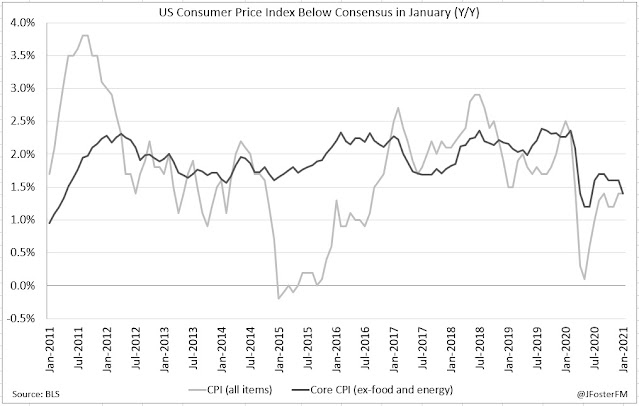In a relatively light-on week in terms of major events, markets were left to negotiate the tension between the reflation narrative, subdued US CPI data and comments from Federal Reserve Chair Jerome Powell that sustained inflationary pressures were unlikely to be forthcoming. Over recent days the Biden Administration's $1.9bn fiscal stimulus bill has come under criticism that it could spark higher inflation, most notably from their own side of the aisle from the former Treasury Secretary and head of the National Economic Council Lawrence Summers. Among a range of other concerns, the most pertinent issue raised by Summers was that the size of the stimulus could risk overheating the economy down the track as it opens up more widely once the pandemic dissipates.
Current Treasury Secretary Janet Yellen has urged lawmakers to "act big" on relief spending measures arguing that the benefits would outweigh the risks and help prevent longer-term damage to the US economy's growth potential. Closely aligning with this were remarks by Fed Chair Powell in an address to the Economic Club of New York where the hit to the labour market from the pandemic crisis was the main area of discussion. Chair Powell outlined that with the effective unemployment rate in the US likely to be in the order of 10%—much higher than the 6.3% level reported last week—getting back to and maintaining full employment "will require more than supportive monetary policy" calling for a society-wide effort to address the situation akin to what occurred in the post-war period 75 years ago. Certainly, this week's soft CPI print in January means that repairing the labour market will continue to take pre-eminence over concerns of potential overheating in the economy. Headline CPI maintained its 1.4% annual rate while the core measure eased to 1.4% from 1.6%, both slower than expected (see chart). While the pace is likely to rise sharply in the months ahead when weak readings from the height of the crisis last year are replaced by stronger outturns from the reopening phase, Chair Powell said that the current weakness in the labour market meant that inflationary pressures were not expected to be "large nor sustained". While there are segments of the market that are of the view that strong inflation could prove more persistent, in the absence of those outcomes the Fed's commitment to its average inflation targeting regime remains clear.
Chart of the week
Over in Europe, the Commission's winter economic forecasts were upgraded reflecting a recovery that is expected to gather pace over the second half of the year as the vaccine is rolled out more widely, enabling the weight of the current shutdowns to be lifted. With the contraction in GDP in 2020 (-6.8%) now seen as less severe than previously anticipated (-7.8%), growth for 2021 is forecast to rise by 3.8% (from 4.2%) and then by a further 3.8% in 2022 (from 3.0%). At the Member State level on the updated outlook, GDP is on track to return to pre-pandemic levels by the end of the year or in early 2022, though some will see an even more protracted recovery, especially where tourism and leisure make up a larger share of the economy. The effect of a more robust rebound this year was reflected in an upgrade to the inflation forecast to 1.4% from 1.1%, though this still leaves it well short of the ECB's target and it is then projected to ease back to 1.3% in 2022 as elevated slack in the labour market weighs. In the UK, the first estimate of GDP growth in Q4 surprised to the upside of estimates coming in at 1.0%, reducing the annual decline to -7.8% from -8.6%. Given that UK GDP was crunched 21.4% through the first half of the year, activity was robust in the second half rising by 17.3%. But the net result was that the economy was still 7.8% smaller than it was prior to the onset of the pandemic, and there will be a degree of backsliding in Q1 due to the impact of the national shutdown with the Bank of England's updated forecasts out last week placing this in the order of a 4% contraction.
— — —
From a local perspective, the announcement by the Victorian Government of a snap 5-day circuit breaker shutdown stemming from virus cases acquired through hotel quarantine rattled sentiment going into the weekend. The action is similar to what has occurred in a few other states over recent times where shutdowns have been enacted largely as a precautionary response to the emergence of cases rather than to curtail large outbreaks, proving to be effective in those instances with restrictions lifted either as planned or a little earlier. This week's data points provided a snapshot of conditions in the Australian economy in the absence of significant restrictions. Consumer sentiment according to the Westpac-Melbourne Institute Index lifted 1.9% for the month in February, with the level at 109.1 sitting just below decade highs. Driving the result was a 6.9% rise in the assessment of the economic outlook over the coming 12 months—unemployment expectations improving on the back of this—while perceptions around household finances looking to the year ahead firmed by 2.6%. The NAB's Business Survey for January reported a rise in the confidence index from +5 to an above-average reading of +10, with retailers and wholesalers remaining the most optimistic in response to the very strong pace of growth in household spending. While the conditions index pulled back to +7 from +16, it also sits above its long-term average. The slowing was driven mainly by the employment sub-component (+10 to +3), though it was still sending a positive signal for future hiring. Other points to highlight are that capacity utilisation has recovered to be around pre-pandemic levels after ticking higher in the month, while purchase and labour costs and retail prices pointed to a subdued inflationary pulse.


